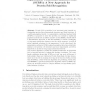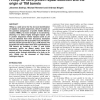107 search results - page 2 / 22 » Protein Fold Recognition using a Structural Hidden Markov Mo... |
RECOMB
2005
Springer
14 years 7 months ago
2005
Springer
Abstract. Protein fold recognition is an important step towards understanding protein three-dimensional structures and their functions. A conditional graphical model, i.e. segmenta...
NAR
2006
13 years 7 months ago
2006
The FISH server is highly accurate in identifying the family membership of domains in a query protein sequence, even in the case of very low sequence identities to known homologue...
BMCBI
2006
13 years 7 months ago
2006
Background: The accuracy of protein secondary structure prediction has been improving steadily towards the 88% estimated theoretical limit. There are two types of prediction algor...
BIBM
2008
IEEE
14 years 2 months ago
2008
IEEE
Protein fold recognition is the prediction of protein’s tertiary structure (Fold) given the protein’s sequence without relying on sequence similarity. Using machine learning t...
NAR
2006
13 years 7 months ago
2006
HHrep is a web server for the de novo identification of repeats in protein sequences, which is based on the pairwise comparison of profile hidden Markov models (HMMs). Its main st...


